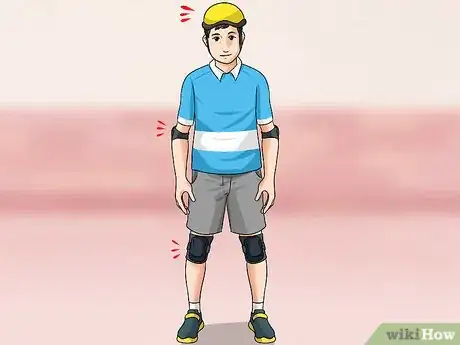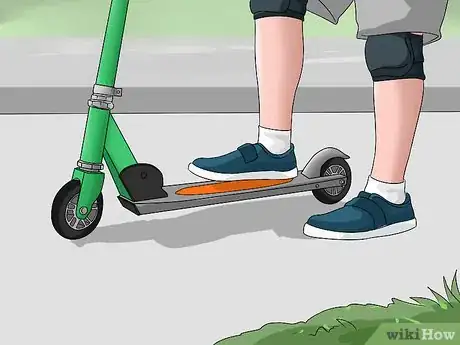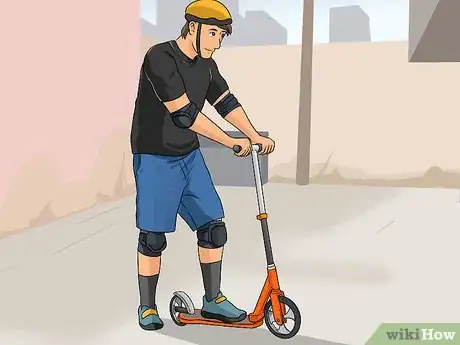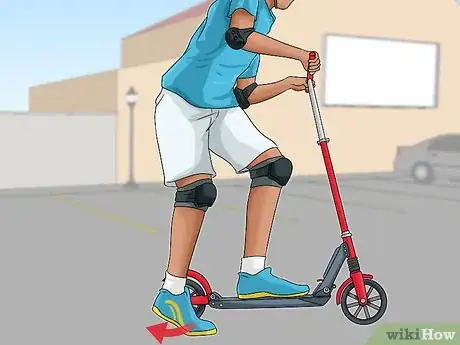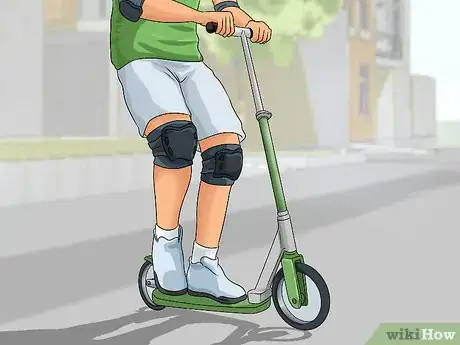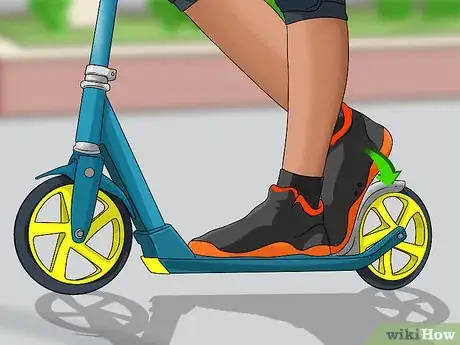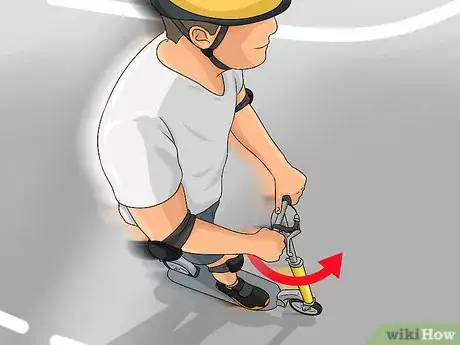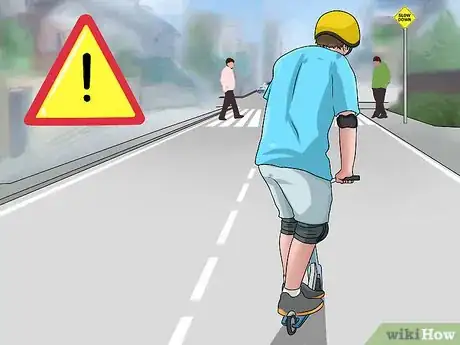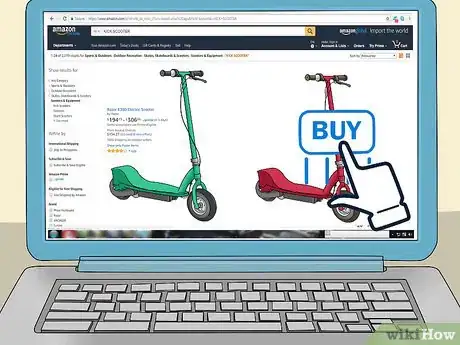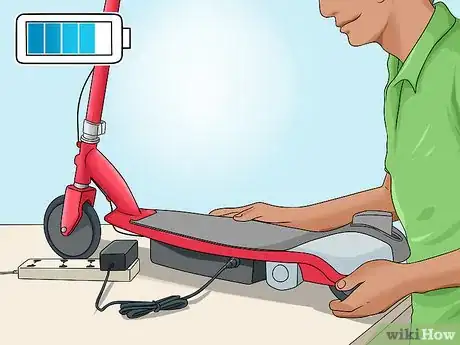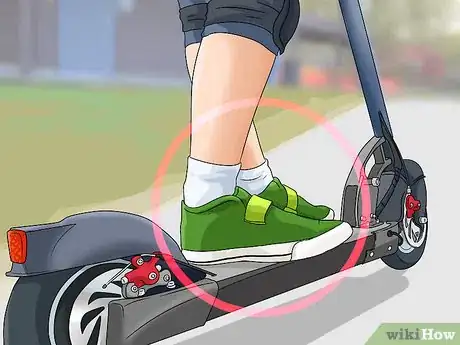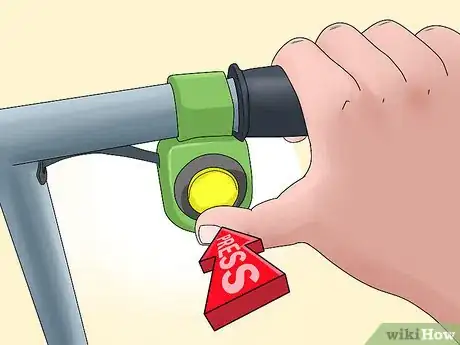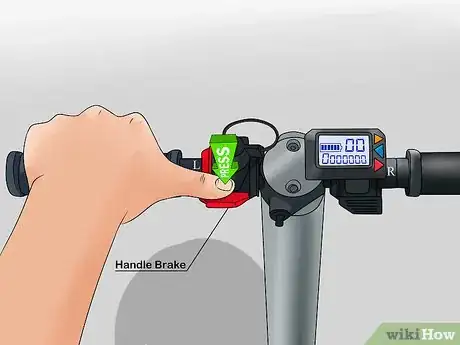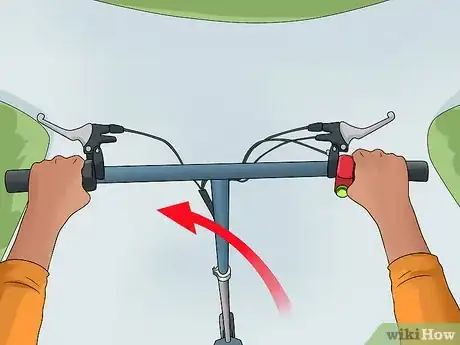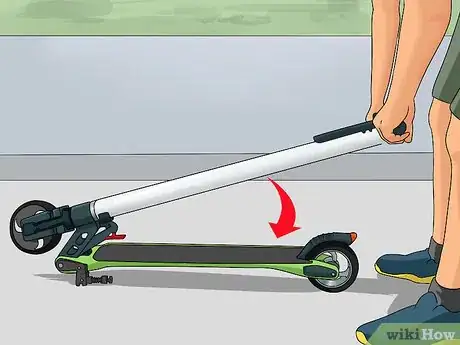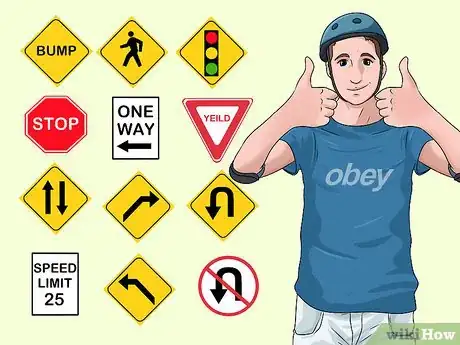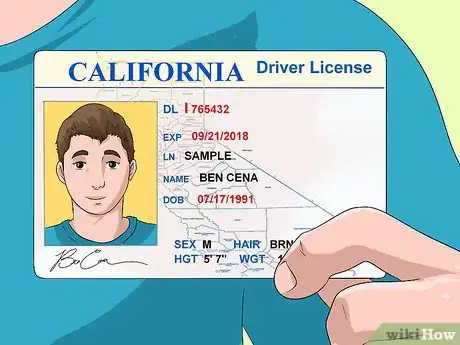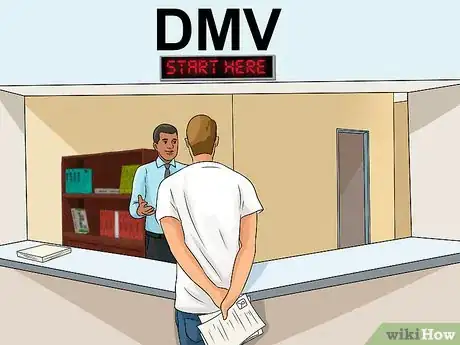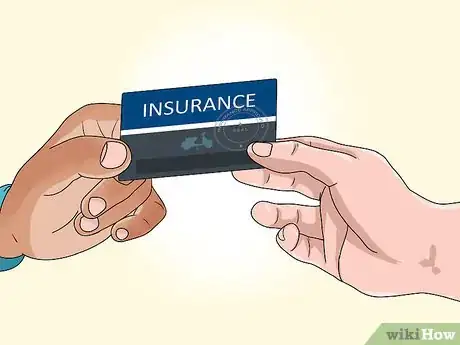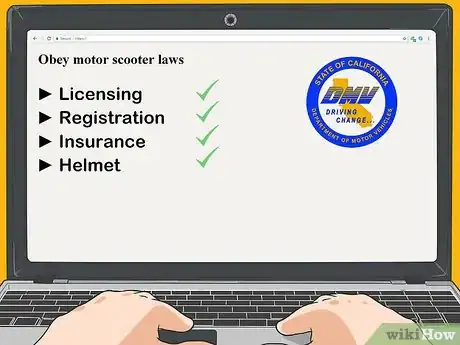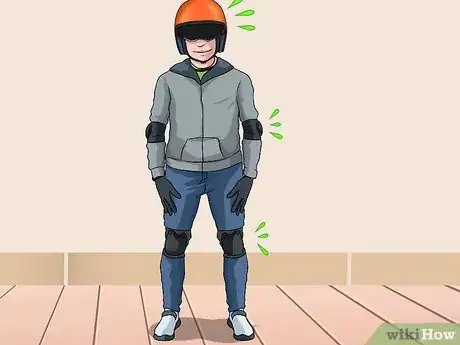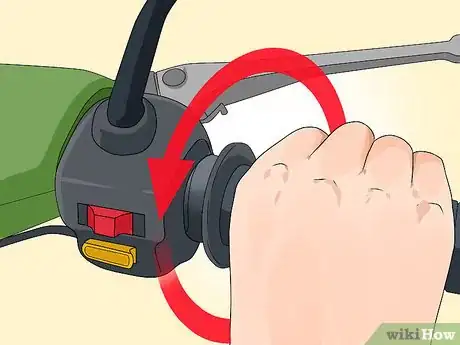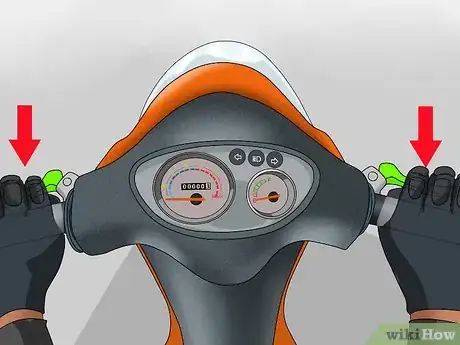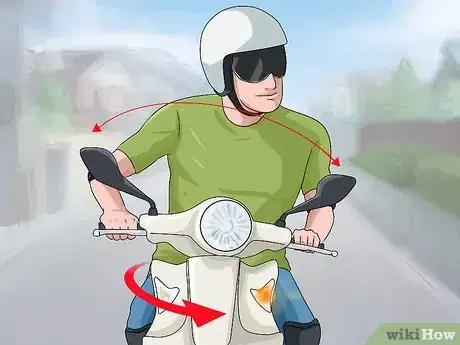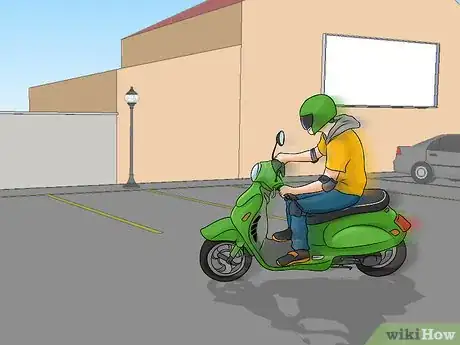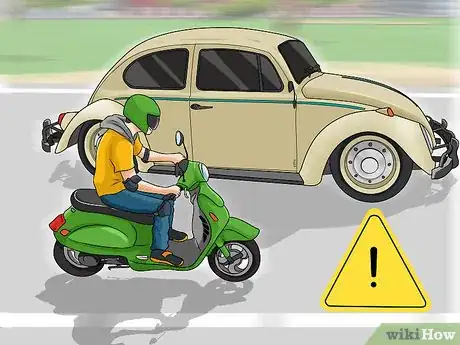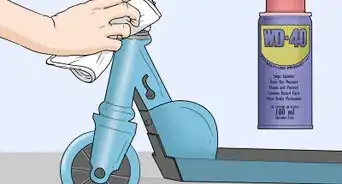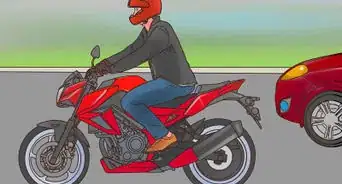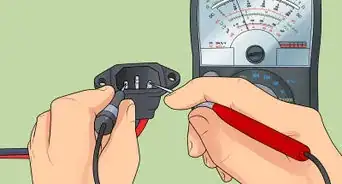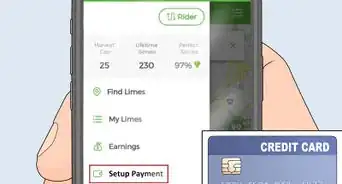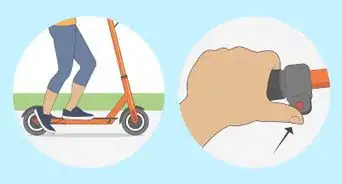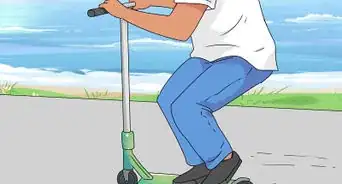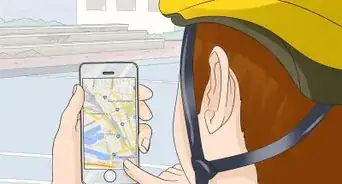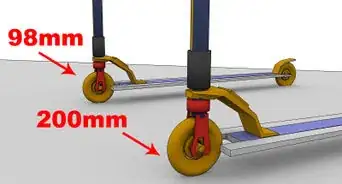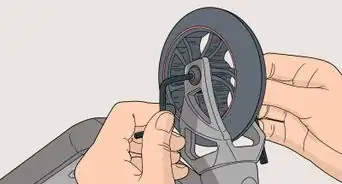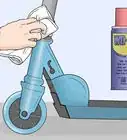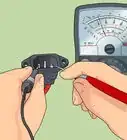This article was co-authored by wikiHow Staff. Our trained team of editors and researchers validate articles for accuracy and comprehensiveness. wikiHow's Content Management Team carefully monitors the work from our editorial staff to ensure that each article is backed by trusted research and meets our high quality standards.
There are 8 references cited in this article, which can be found at the bottom of the page.
wikiHow marks an article as reader-approved once it receives enough positive feedback. In this case, 81% of readers who voted found the article helpful, earning it our reader-approved status.
This article has been viewed 314,064 times.
Learn more...
Riding a scooter is a great form of transportation. Scooters are generally much more efficient than cars and can get you to your destination much faster than walking. There are different kinds of scooters, like a kick scooter, a stand-up electric scooter, and a motor scooter. Each type of scooter is operated differently and has different rules and regulations. Be sure to check your scooter’s manual for instructions for your specific scooter.
Steps
Riding a Kick Scooter
-
1Wear protective gear. Make sure to put on a bike helmet. Even though you may feel you don't need one, a helmet will keep you safe, especially when learning. It is also advisable to wear knee pads, elbow pads, and wrist guards to protect you if you fall.
-
2Start on a flat, paved road. Find a long stretch of a flat road, with as few cracks and ruts as possible. This ensures a smooth ride and is easier to learn on. It will require less effort to move yourself forward too.Advertisement
-
3Use a proper stance. Place your weak leg on the middle of the scooter’s deck. It should be facing straight ahead. Your knee should be bent. Lean forward slightly and grip the handlebars with both hands. Keep your other foot on the ground.
- Keep the front tube (the front part of the scooter that supports the handlebars) straight at all times while riding unless you're doing a trick that requires otherwise. That's the key to balancing on a scooter.
-
4Push off the ground with your strong leg. While your planted leg is securely in place on the deck and bent at the knee, use your strong leg to push off of the ground. This will propel you forward. As you kick, straighten your planted leg to generate more momentum, then bend it back for your next kick. To kick, use long, powerful strides as opposed to small, quick ones. Make contact with the ground on the ball of your foot and push back almost like you would while running.
- To glide, keep your kicking foot up, maybe a few inches off the ground, so that you can stabilize yourself in case you start to tip.
-
5Balance both feet on your scooter when you have enough momentum. Once you have your balance and have picked up speed, move your kicking foot onto the scooter, behind your other foot. Turn your feet at a ninety-degree angle, similar to riding a skateboard. This will help you to travel at speed more aerodynamically.
-
6Brake smoothly when needed. To stop, hit your brake with your back (kicking) foot. Keep your foot there for a few seconds until you come to a complete stop. Press down on the brake gradually so that you don’t stop too quickly. If you only tap the break, you'll stop for a second and keep going.
- To use handbrakes, simply squeeze on the brakes gradually with your fingers. They will be on your handlebar.
- To control your speed, don’t rely on brakes alone. Be sure you aren’t kicking too quickly. You can also drag your kicking foot lightly on the ground to slow down. Make sure you are wearing solid shoes when doing this.
-
7Rotate the handlebar to turn. Take a curve by slowly rotating the handlebar in the direction you wish to turn. If you make a sudden swerve, you may fall.
-
8Exercise safety precautions. Ride at a safe speed. Be aware of pedestrians, especially in urban areas. Make sure you are always in control of your scooter and able to stop when needed.
- Don’t go at top speed down a hill, you will likely lose control. When going downhill, keep one foot on the brake and press it lightly as you go down. This will keep you from going too fast or losing control.
- Always yield to cars; pull over to the side of the road when you hear a car behind you.
- Make sure to obey stop signs and other traffic laws.
- If you're going to crash into something, just jump off your scooter. To do this, jump and land so that the scooter's deck is between your feet. Then let go of the handlebars. It's a surefire way to not get hurt in a scooter crash.
Riding a Stand-Up Electric Scooter
-
1Buy an electric scooter. A stand-up electric scooter will cost at least $1,000. The Uscooter costs $1,000, EcoReco’s M5 costs $1,250, and Go-Ped’s costs about $1,500. Scooters can be bought on Amazon or on each company's respective website.[1]
-
2Charge your scooter. Make sure your scooter is fully charged ahead of time. By plugging it in once a week for a few hours, you should be good to go.[2]
- Using the foot brake also recharges the UScooter. It has a regenerative braking system.
- Be aware of your scooter’s limitations. The UScooter has a 21-mile range.
-
3A full-face helmet is better if you plan to ride your scooter regularly at speeds of 25 km/h. Falling at this speed can cause serious injuries and even fractures. You could even lose your teeth or break your jaw without a helmet. Protecting your head from these injuries is essential. To prevent high winds, grit and insects from impairing your vision, you need to shield your eyes. It is unsafe to ride an electric scooter with your eyes closed if you have teary eyes.[3]
-
4Place both feet on the deck. Your feet should both be planted on the deck and should not need to leave the deck unless you need to get off of the scooter. Place your feet next to each other, facing straight forward in the middle of the deck.[4]
- When going at speed, you can angle your feet to the same side for a more aerodynamic stance.
-
5Accelerate with your right hand. Press the throttle button with your ride thumb to speed up. Continue to press the throttle to go as fast as you desire.[5]
-
6Brake with your left hand. Press the brakes with your left thumb to gradually slow down. Use the foot brake at the back of your scooter as another way of slowing down. Simply press down on the brake by moving one foot towards the back of the scooter and keeping the other one planted in the front.[6]
-
7Rotate the handlebars to turn. Be sure to make gradual turns or you will fall! Slowly rotate your handlebars to the right or left, depending on which direction you wish to turn.[7]
-
8Fold up the scooter when it is not in use. Press your scooter's release button with your foot and fold the scooter in half until it clicks in place. Fold in the handlebars as well. Folding your scooter allows you to easily transport it and store it when you can’t ride it.[8]
- The UScooter has a red release button near its deck.
-
9Obey traffic laws. Make sure to stop at stop signs. Always yield to cars and pedestrians. Don’t go at full speed on crowded sidewalks.
- Make sure it is legal to ride the scooter in your area. Laws are still being made about where you can and can’t ride an electric scooter. To find out the laws for your area, check with your local DMV.[9]
Preparing to Ride a Motor Scooter
-
1Take a safety or training course. This will help you to learn the basics and get prepared to go out on the road. It will also train you on how to avoid problems and what to do in special or dangerous situations. You can find one at the Motorcycle Safety Foundation or your local DMV.[10]
- You could even get a discount on insurance by taking a safety course.
-
2Get a license. License requirements vary in each state. In general, if your scooter is over 50cc (which most scooters are), you will need a license. It generally entails getting a “motorcycle endorsement” on your regular driver’s license. Go to your local DMV to get this taken care of.[11]
- To get your license, you will need to take a written test. Your DMV can provide a motorcycle manual for you to study and prepare.
- If you don’t have a driver’s license, it can be more difficult to get a motorcycle license. But some states will allow you to get a license strictly for motorcycles. Check with your local DMV.
-
3Register your scooter. Many states require you to register your motor scooter, especially if it is above 50cc. This can also be done at your DVM. You will pay a small fee (around $30) and they will give you your paper registration and license plate.[12]
-
4Get insurance. You will likely need basic liability insurance to legally operate your scooter. You can check with your DMV for your state’s laws and requirements regarding insurance. You can get scooter insurance at most major insurance agencies, such as Esurance.[13]
- Get a free scooter insurance quote at esurance.com/insurance/scooter.
-
5Obey motor scooter laws. Besides licensing, registration, and insurance, depending on the size of your scooter, there are some places where it will be allowed, and other places where it might not be allowed (such as taking a small scooter on a highway). It is important to know the laws in your area. Since laws vary across each state, make sure to find out your local laws at the DMV.[14]
-
6Wear protective gear. Always wear a full-coverage helmet anytime you go on a motor scooter. This is the most important safety precaution you can take. Be sure that it has a visor to protect your eyes. If it doesn’t, use goggles. Your eyes need to be protected when traveling at high speeds.[15]
- Protect yourself by fully covering your body. Wear a thick jacket, such as one made of leather, and thick riding pants, which can be leather or a tough synthetic material.
- Always wear gloves, even if it is hot out. They will protect your hands and allow you to grip the controls easily.
- Wear sturdy boots that cover your ankles, preferable ones made of strong leather. The ankle is a very vulnerable area in case of a fall.
Riding a Motor Scooter
-
1Accelerate gradually. To speed up, simply twist the hand-grip throttle with your right hand. Twist the throttle away from you until you are at your desired speed.[16]
- You will be able to go different speeds depending on the size of your motor scooter. A smaller scooter (125cc to 150cc) can travel 65mph.[17]
-
2Brake with both hands. To brake on a motor scooter, press the hand brakes with both hands, similar to how you would on a bicycle. The right hand will usually control the front brake and the left hand will control the rear brake.[18]
-
3Lean into your turns. When turning on a motor scooter, you must tilt the handlebar towards the side you wish to turn and actually lean your body in that direction. Your scooter should naturally lean in the direction that you are pressing the handlebar and it is important to get used to this.[19]
- Practice turning slowly at first. As you increase the speed of your turns, you will also need to lean more.
-
4Practice in an empty parking lot. Getting comfortable on a motor scooter can take some time. Go to an empty parking lot and spend time driving your scooter around. Practice accelerating, braking and turning until you are comfortable doing so. Then try out your scooter on a slow street and gradually progress to higher speeds.[20]
-
5Use caution on the road. Scooters are lightweight and not the most stable at high speeds. When going fast, use extreme caution. Always yield to cars. Keep in mind that there is nothing protecting you from the road should you fall. Always follow all motor scooter laws. To find out these laws, ask your local DMV.[21]
- Keep in mind that driving laws for motor scooters are more similar to cars than bikes. If you are used to riding a bike, it might be difficult to break these instincts. Motor scooters are driven in the middle of the road and obey all traffic signals and signs just as you would in a car.[22]
Community Q&A
-
QuestionIs it difficult to ride a scooter?
 Drew Hawkins1Community AnswerWhile it may take some practice, special training, and a license to operate a motorized scooter, a simple kick scooter is super easy to ride! Just make sure you wear a bike helmet to protect your head in case you fall. You could also wear knee pads, elbow pads, and wrist guards to be extra safe. Find a long stretch of a flat road, with as few cracks and ruts as possible and place your non-dominant leg on the middle of the scooter's deck. Use your strong leg to push off of the ground and move yourself forward. Once you have your balance and have picked up speed, move your kicking foot onto the scooter, behind your other foot. Whenever you want to pick up speed, just kick off the ground some more! Whenever you want to slow down or stop, press on the brake that covers the back wheel until you come to a stop. Now get out there and have some fun!
Drew Hawkins1Community AnswerWhile it may take some practice, special training, and a license to operate a motorized scooter, a simple kick scooter is super easy to ride! Just make sure you wear a bike helmet to protect your head in case you fall. You could also wear knee pads, elbow pads, and wrist guards to be extra safe. Find a long stretch of a flat road, with as few cracks and ruts as possible and place your non-dominant leg on the middle of the scooter's deck. Use your strong leg to push off of the ground and move yourself forward. Once you have your balance and have picked up speed, move your kicking foot onto the scooter, behind your other foot. Whenever you want to pick up speed, just kick off the ground some more! Whenever you want to slow down or stop, press on the brake that covers the back wheel until you come to a stop. Now get out there and have some fun! -
QuestionIs a scooter faster than walking?
 Drew Hawkins1Community AnswerWhile it can depend on how fast you're going and how smooth the road is, yes riding a scooter is generally faster than walking. In fact, if you're on a well-paved road, a scooter is about 5 times faster than walking at an average pace. And that's just with a simple kick scooter. If you have an electric or motorized scooter, you'll move even faster! Just make sure you wear a helmet and protective gear so you don't get hurt if you fall.
Drew Hawkins1Community AnswerWhile it can depend on how fast you're going and how smooth the road is, yes riding a scooter is generally faster than walking. In fact, if you're on a well-paved road, a scooter is about 5 times faster than walking at an average pace. And that's just with a simple kick scooter. If you have an electric or motorized scooter, you'll move even faster! Just make sure you wear a helmet and protective gear so you don't get hurt if you fall. -
QuestionHow do I learn to ride a scooter?
 Drew Hawkins1Community AnswerThere are plenty of ways you can learn how to ride a scooter. Probably the best and most effective way is to take lessons with a trained rider. They'll be able to show you the ropes and teach how to ride safely and effectively. If you have a friend who rides a scooter often, they may be able to help you learn as well and teach you the basics. If you don't have access to a teacher or a friend who rides, try looking up videos about how to ride a scooter. Look for ones for beginners that go over the basics so you can get the fundamentals down before you give it a shot. Start small and practice often. In time, you'll get more comfortable and better at it.
Drew Hawkins1Community AnswerThere are plenty of ways you can learn how to ride a scooter. Probably the best and most effective way is to take lessons with a trained rider. They'll be able to show you the ropes and teach how to ride safely and effectively. If you have a friend who rides a scooter often, they may be able to help you learn as well and teach you the basics. If you don't have access to a teacher or a friend who rides, try looking up videos about how to ride a scooter. Look for ones for beginners that go over the basics so you can get the fundamentals down before you give it a shot. Start small and practice often. In time, you'll get more comfortable and better at it.
wikiHow Video: How to Ride a Scooter
Warnings
- Do not attempt to speed down a steep hill. You will most likely lose control of the scooter.⧼thumbs_response⧽
- Watch the road in front of you for sudden holes or cracks. If you don't see them in time, you can crash.⧼thumbs_response⧽
- Don’t worry about looking cool on a stand-up scooter. No one looks cool on stand-up scooters! Just have fun.⧼thumbs_response⧽
- Let skateboarders have the right of way at skate parks. They don’t always look fondly on scooters.⧼thumbs_response⧽
- Listen for cars and yield to cars and pedestrians.⧼thumbs_response⧽
References
- ↑ https://www.wired.com/2016/01/electric-scooters-uscooter-future/
- ↑ https://www.wired.com/2016/01/electric-scooters-uscooter-future/
- ↑ https://concurrent-controls.com/scooter-helmets/
- ↑ https://www.wired.com/2016/01/electric-scooters-uscooter-future/
- ↑ https://www.wired.com/2016/01/electric-scooters-uscooter-future/
- ↑ https://www.wired.com/2016/01/electric-scooters-uscooter-future/
- ↑ https://www.wired.com/2016/01/electric-scooters-uscooter-future/
- ↑ https://www.wired.com/2016/01/electric-scooters-uscooter-future/
- ↑ https://www.wired.com/2016/01/electric-scooters-uscooter-future/
- ↑ https://www.esurance.com/info/scooter/how-to-ride-a-scooter
- ↑ http://www.motor-scooters-guide.com/motor-scooter-laws.html
- ↑ http://www.motor-scooters-guide.com/motor-scooter-laws.html
- ↑ https://www.esurance.com/info/scooter/how-to-ride-a-scooter
- ↑ http://www.msf-usa.org/downloads/YouAndYourScooter2016.pdf
- ↑ http://www.msf-usa.org/downloads/YouAndYourScooter2016.pdf
- ↑ http://traveltips.usatoday.com/difference-between-scooter-motorcycle-100182.html
- ↑ http://www.motor-scooters-guide.com/motorcycle-scooter.html
- ↑ http://www.motor-scooters-guide.com/motorcycle-scooter.html
- ↑ http://www.msf-usa.org/downloads/YouAndYourScooter2016.pdf
- ↑ http://www.artofmanliness.com/2011/06/02/learning-to-ride-your-first-motorcycle/
- ↑ http://traveltips.usatoday.com/difference-between-scooter-motorcycle-100182.html
- ↑ http://www.motor-scooters-guide.com/motor-scooter-laws.html
About This Article
To learn how to ride a scooter, first find a smooth, paved surface you can practice on. Make sure it’s in a low-traffic area, like an empty sidewalk or driveway. Wear a helmet in case you fall, and consider wearing knee and elbow pads for extra protection. Place your scooter on a flat surface and grip the handlebars. Then, place your non-dominant foot on the center of the deck pointing straight ahead, and leave your dominant foot on the ground. Your dominant foot is usually the foot you kick with. To start moving, push off of the ground with your dominant foot. Hold your dominant foot a few inches off the ground so you can catch yourself if you start to lose your balance. Push off with your dominant foot again to continue moving forward. Once you’re comfortable balancing and you have enough momentum, place your dominant foot on the deck behind your other foot. To turn, slowly rotate the handlebars in the direction you want to go. Push off again with your dominant foot whenever you start to slow down. If you need to stop, gradually press down on the brake with your back foot. You can also drag your back foot lightly on the ground to slow yourself down. For more tips, like how to ride a kick scooter, read on!
